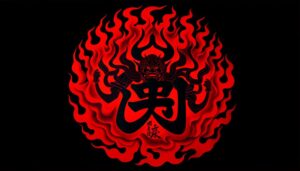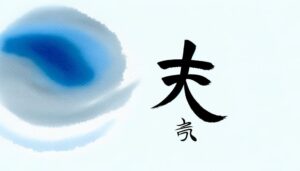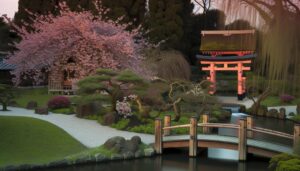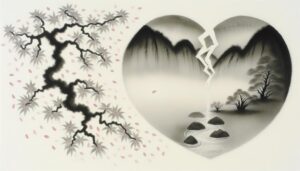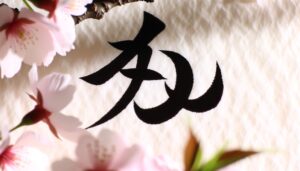How to Write and Understand the Japanese Symbol for Hope
In Japanese culture, several symbols embody hope. Cherry blossoms, celebrated for their fleeting beauty, represent new beginnings and the impermanent nature of life.
The crane, esteemed for its grace, symbolizes longevity and determination. The rising sun conveys rejuvenation, positivity, and strength, closely linked to the sun goddess Amaterasu.
Bamboo stands for fortitude and adaptability, embodying resilience. The Daruma doll, stemming from Zen Buddhism, illustrates dedication and achievement.
Each of these symbols holds a significant place in Japanese tradition, offering a multifaceted view of hope. Further exploration will reveal deeper cultural connections and interpretations.
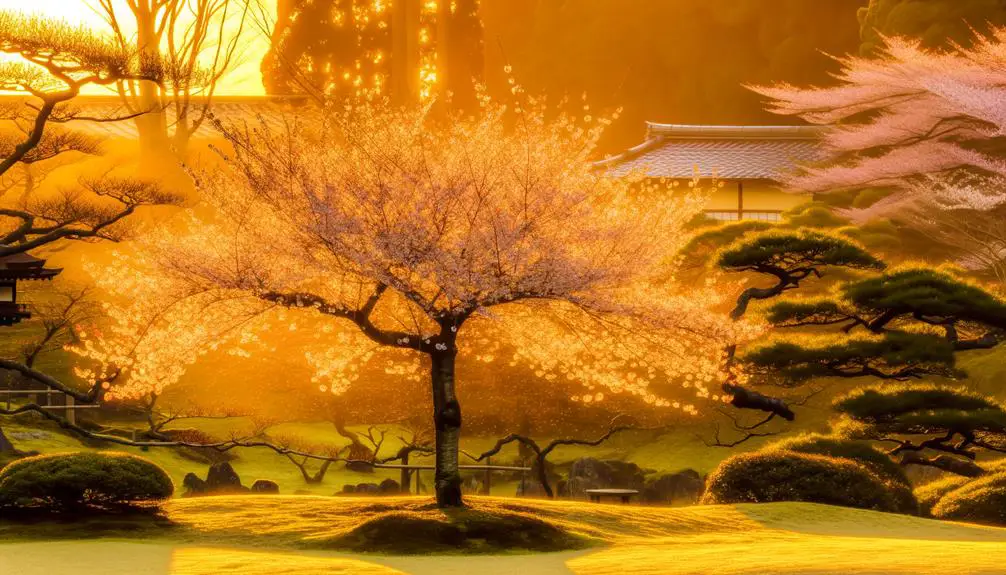
Key Takeaways
- Cherry Blossoms symbolize hope and new beginnings, reflecting the transient nature of life.
- Cranes represent longevity, good fortune, and perseverance, often seen in wedding ceremonies.
- Bamboo signifies strength, flexibility, and resilience, epitomizing recovery and renewal.
- Daruma Dolls embody perseverance and good fortune, serving as physical reminders of commitment and success.
- Koi Fish symbolize perseverance and hope, associated with overcoming adversity and integral to festivals.
Cherry Blossoms
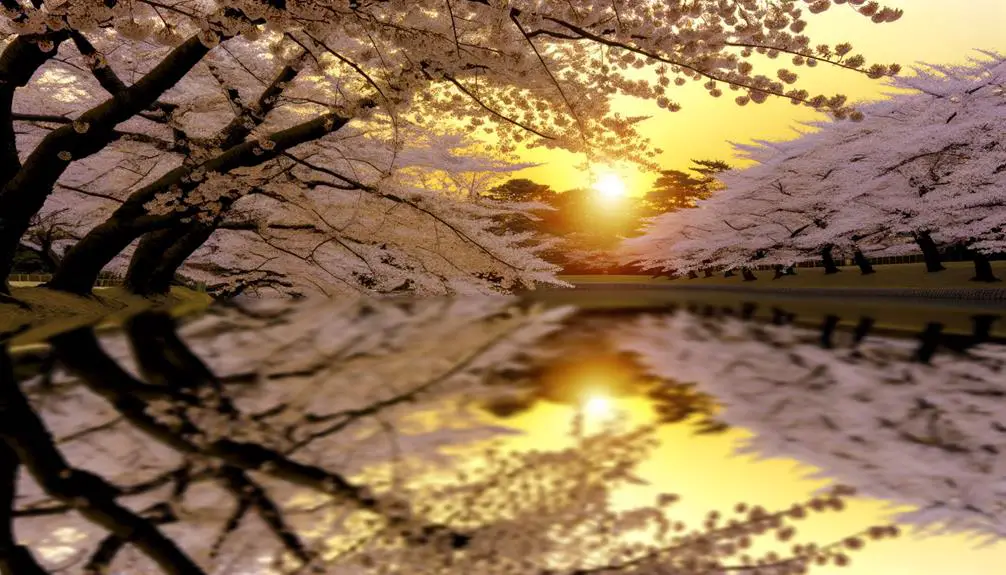
As a quintessential symbol of ephemeral beauty and renewal, cherry blossoms (sakura) hold profound cultural significance in Japan, often epitomizing the transient nature of life itself. Blooming briefly in spring, these delicate flowers invite contemplation on the fleeting moments of existence, fostering a deep appreciation for the present.
Hanami, the traditional custom of flower viewing, underscores this ethos, encouraging communal gatherings beneath blossoming trees to celebrate life's impermanence. The sakura's short-lived bloom also serves as a poignant reminder of mortality and renewal, resonating deeply in Japanese literature, art, and philosophy.
Moreover, cherry blossoms symbolize hope and new beginnings, often coinciding with graduation ceremonies and the start of the fiscal year, intertwining personal and societal rejuvenation.
The Crane
Renowned for its elegance and grace, the crane (tsuru) is a revered symbol in Japanese culture, embodying longevity, fidelity, and good fortune. The crane's association with these virtues stems from ancient folklore and traditional beliefs that attribute a lifespan of a thousand years to the bird.
This mythical longevity has made the crane a powerful emblem of enduring life and perseverance. Additionally, the crane's monogamous nature symbolizes unwavering fidelity, making it a popular motif in wedding ceremonies and decorations.
The act of folding a thousand origami cranes, known as senbazuru, is believed to grant a wish, reflecting the crane's role in manifesting hope and positive outcomes. Therefore, the crane profoundly influences both everyday life and ceremonial practices in Japan.
Rising Sun
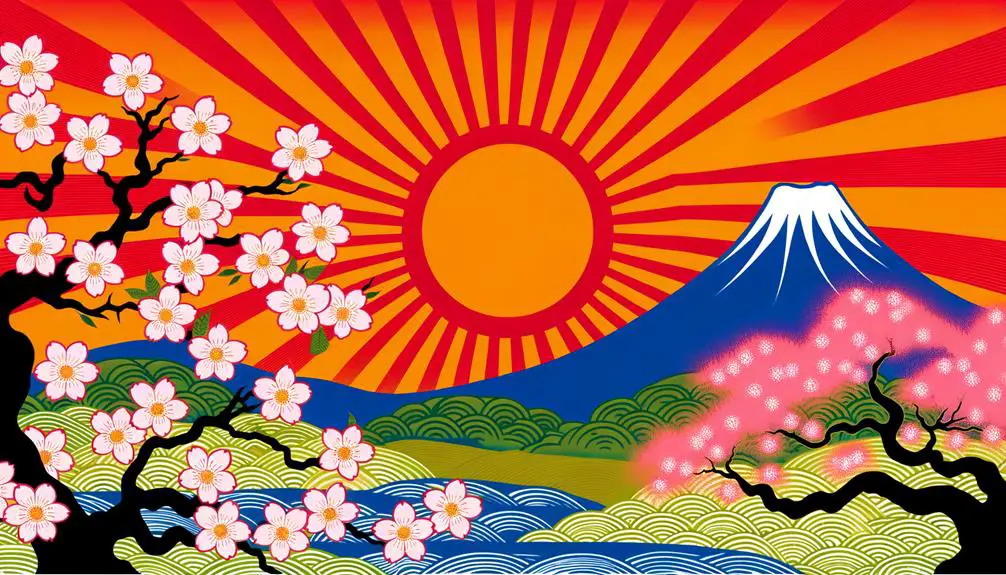
The Rising Sun holds profound historical significance in Japan, symbolizing the nation's origins and imperial lineage.
Culturally, it represents renewal and the enduring spirit of the Japanese people, often depicted in art and national emblems.
Modern interpretations of the Rising Sun continue to evoke a sense of optimism and resilience, reflecting Japan's ability to adapt and thrive through changing times.
Historical Significance
Embodying both national pride and complex historical narratives, the Rising Sun symbol holds a deeply entrenched position in Japan's cultural and political landscape. Originating from ancient times, the Rising Sun has evolved through various historical epochs, each adding layers of meaning.
It is essential to understand its multifaceted significance:
- Ancient Mythology: Linked to Amaterasu, the sun goddess, symbolizing divine origin.
- Feudal Japan: Adopted by samurai and military leaders, representing power and honor.
- Meiji Restoration: Marked Japan's modernization and imperial expansion.
- World War II: Used by the Japanese military, evoking both national pride and controversy.
- Post-war Era: Continues to evoke mixed reactions, reflecting historical wounds and cultural pride.
This symbol encapsulates Japan's journey through its storied past.
Cultural Representation
In contemporary Japan, the Rising Sun symbol permeates various aspects of cultural expression, from traditional festivals and ceremonies to modern art and fashion, reflecting both historical continuity and evolving societal values.
This emblem, deeply rooted in Shinto beliefs and the imperial lineage, appears in events like New Year's celebrations and the enthronement rituals of the Emperor. It also manifests in contemporary aesthetics, influencing graphic design and streetwear, symbolizing resilience and renewal.
The ubiquity of the Rising Sun in these diverse contexts underscores its role as a cultural touchstone, bridging Japan's storied past with its dynamic present.
This cultural representation illustrates how the symbol has been repurposed to resonate with modern sensibilities while maintaining its foundational significance.
Modern Interpretations
Amid Japan's contemporary landscape, the Rising Sun symbol has been reinterpreted through various lenses, reflecting shifts in societal values and global perceptions. Modern interpretations emphasize its role beyond historical contexts, now embodying resilience, renewal, and innovation. This transformation is evident in various domains:
- Art and Design: The motif is frequently used in contemporary art to symbolize new beginnings and creative inspiration.
- Fashion: Designers incorporate the Rising Sun in apparel, merging tradition with modern aesthetics.
- Technology: Tech companies adopt the symbol to signify cutting-edge advancements and forward-thinking.
- Social Movements: Activists employ it to represent hope and collective progress.
- Global Influence: Internationally, the symbol is reimagined to promote cultural exchange and mutual understanding.
These interpretations collectively highlight its evolving and multifaceted significance.
Koi Fish
Renowned for their vibrant colors and graceful movements, koi fish hold a significant place in Japanese culture as enduring symbols of perseverance and hope.
Originating from Chinese carp, koi were selectively bred in Japan for their striking hues. The fish are often associated with overcoming adversity, as illustrated by the legend of koi swimming upstream and transforming into dragons upon reaching the Dragon Gate waterfall. This narrative underscores the virtues of determination and resilience.
In traditional Japanese gardens, koi ponds serve as tranquil sanctuaries, embodying harmony and balance. Additionally, koi are integral to various Japanese festivals, particularly Children's Day, where they symbolize parents' hopes for their children's success and strong will.
Therefore, koi fish epitomize the cultural ethos of steadfastness and optimism.
Bamboo
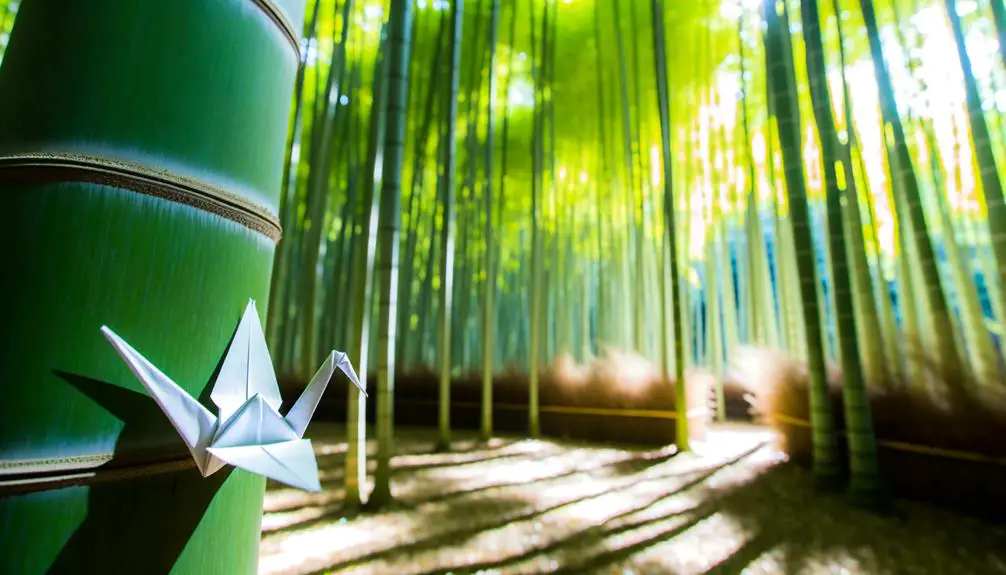
Much like the koi fish, bamboo holds profound symbolic significance in Japanese culture, representing strength, flexibility, and resilience. Bamboo's ability to withstand harsh conditions and still thrive makes it a powerful emblem of hope and endurance. It is deeply woven into the fabric of Japanese art, literature, and daily life.
- Strength: Bamboo's sturdy structure symbolizes unwavering fortitude.
- Flexibility: Its ability to bend without breaking epitomizes adaptability.
- Resilience: Bamboo's rapid regeneration signifies recovery and renewal.
- Cultural Importance: It appears in traditional festivals, symbolizing purity and protection.
- Aesthetic Appeal: Its elegant form is a staple in Japanese gardens and architecture.
These qualities collectively render bamboo a poignant symbol of hope and perseverance in Japanese society.
Pine Tree
The pine tree, revered for its evergreen nature, embodies longevity, endurance, and steadfastness in Japanese culture. Its persistent greenery throughout the seasons symbolizes resilience and eternal life, making it a prominent feature in traditional Japanese gardens and art.
Pine trees are often planted alongside temples and shrines, signifying a spiritual connection and enduring strength. Additionally, in the context of the Japanese New Year, pine branches are used in 'kadomatsu' decorations to invite prosperity and protect against misfortune.
This cultural reverence is further reflected in classical literature and poetry, where the pine tree is a metaphor for unwavering constancy. Hence, the pine tree's symbolism is deeply interwoven with Japan's appreciation for nature's enduring virtues and the aspiration for a hopeful future.
Plum Blossoms
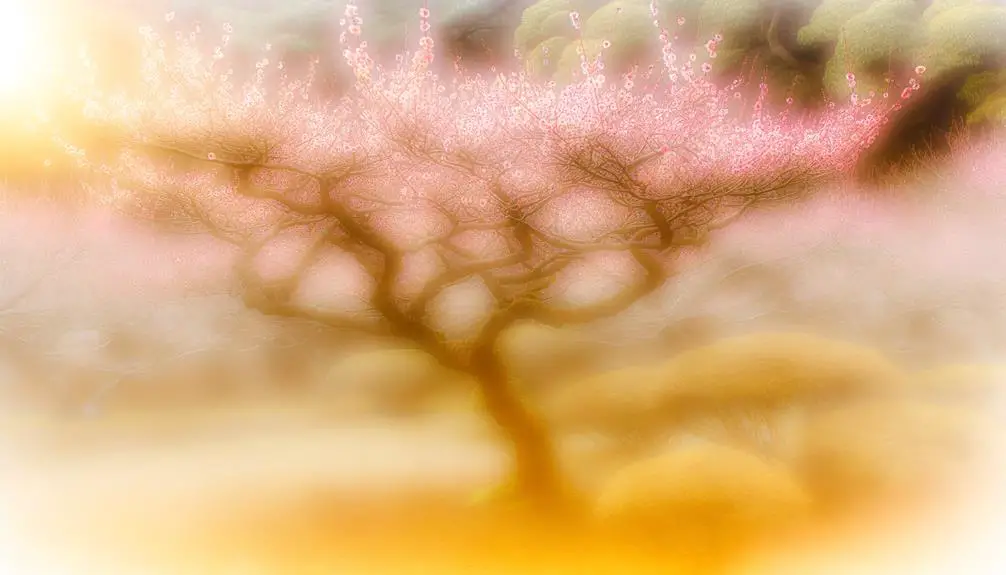
In Japanese culture, plum blossoms are celebrated as harbingers of spring and symbols of resilience, purity, and renewal. These delicate flowers bloom amidst the harshness of winter, embodying the strength to flourish under adverse conditions.
Historically, plum blossoms have been revered in poetry, art, and festivals, signifying the arrival of warmer days and new beginnings.
The cultural significance of plum blossoms can be summarized as follows:
- Resilience: Flourishing despite the cold.
- Purity: Representing unblemished beauty.
- Renewal: Signaling the end of winter and the start of spring.
- Historical Relevance: Prominent in traditional Japanese art and literature.
- Celebration: Central to festivals such as Ume Matsuri.
This multifaceted symbolism reinforces their revered status in Japanese culture.
Daruma Doll
Embodying perseverance and good fortune, the Daruma doll stands as a potent symbol within Japanese culture, inspiring individuals to achieve their goals and overcome obstacles.
Originating from the teachings of Bodhidharma, the founder of Zen Buddhism, the doll's unique design—round and weighted at the bottom—ensures it rights itself when toppled, symbolizing resilience.
The practice of painting one eye while setting a goal and completing the other upon achievement serves as a physical manifestation of commitment and success.
Traditionally red, the Daruma's colors and expressions may vary, but its essence remains unchanged.
This ritualistic tool not only emphasizes personal perseverance but also acts as a cultural reminder of the virtues of patience and determination in the face of adversity.
Origami Art
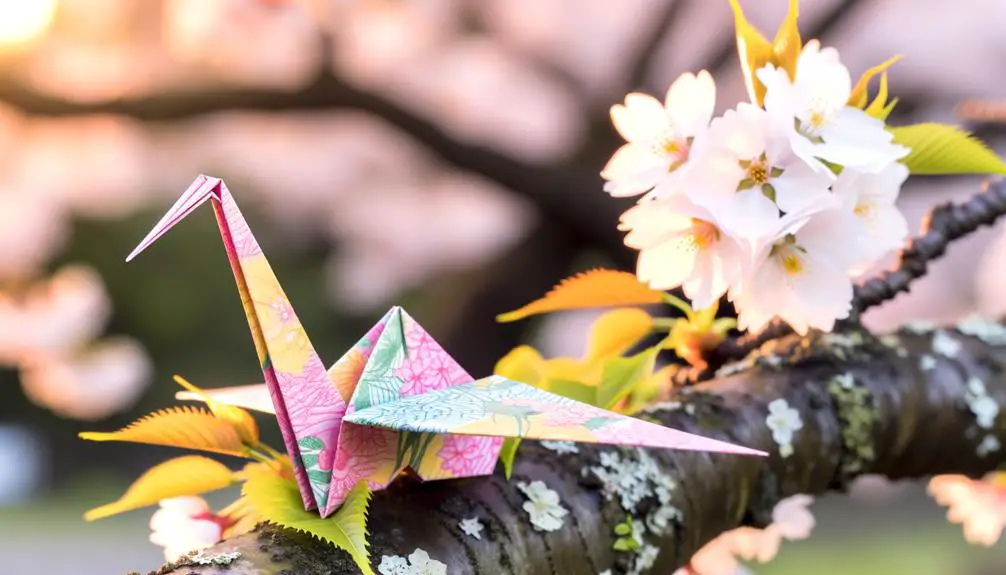
Origami, the intricate Japanese art of paper folding, transforms a simple sheet of paper into detailed and expressive sculptures, reflecting cultural values of precision, creativity, and discipline. Originating in the 17th century, origami has evolved into a symbolic and artistic practice, embodying hope and perseverance through its complex structures.
The practice involves meticulous techniques that require both patience and skill, creating an interplay between simplicity and sophistication.
- Cranes (Tsuru): Symbolize peace and long life.
- Lotus Flowers: Represent purity and spiritual awakening.
- Butterflies: Signify marital happiness.
- Frogs: Considered lucky and symbolize fertility.
- Stars: Often associated with wishes and dreams.
These intricate designs not only enhance aesthetic appeal but also serve as profound metaphors for resilience and transformation.
Mount Fuji
Standing majestically as Japan's highest peak, Mount Fuji embodies a potent symbol of natural beauty, cultural significance, and spiritual reverence, enchanting both locals and visitors alike. This dormant stratovolcano, standing at 3,776 meters, is a UNESCO World Heritage Site, reflecting its profound cultural and historical importance. The iconic shape of Mount Fuji has inspired countless works of art, literature, and religious practice, serving as a pilgrimage site for centuries. Its majestic presence is not merely a geographical feature but a repository of Japan's collective identity and aspirations.
| Attribute | Details |
|---|---|
| Height | 3,776 meters |
| Location | Honshu Island |
| UNESCO Status | World Heritage Site |
| Cultural Impact | Art, literature, and pilgrimage |
| Geological Type | Dormant stratovolcano |
Mount Fuji symbolizes resilience and inspiration.
New Year's Wishes
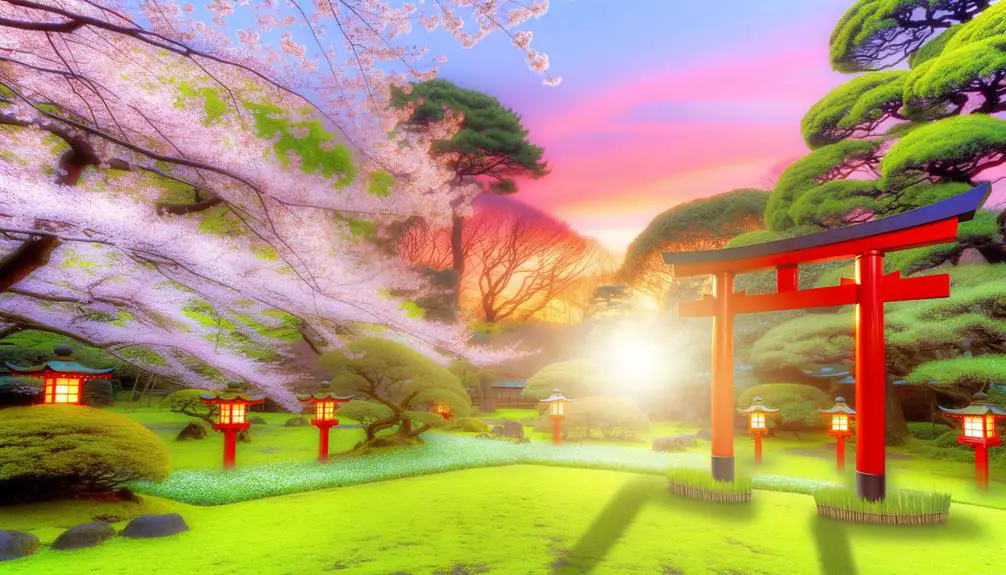
Crafting New Year's wishes in Japan is a cherished tradition that intertwines cultural practices, symbolic gestures, and personal aspirations to welcome the forthcoming year with hope and positivity. These wishes, often written on special cards or displayed in homes, carry deep significance. They reflect a blend of historical customs and modern-day dreams, serving as a symbolic fresh start each January.
Key elements of Japanese New Year's wishes include:
- Nengajo: Traditional New Year's postcards sent to friends and family.
- Kadomatsu: Pine and bamboo decorations symbolizing longevity and prosperity.
- Hatsumode: First shrine visit of the year for prayers and wishes.
- Daruma dolls: Used for setting and achieving personal goals.
- Kagamimochi: Rice cake offerings representing continuity and renewal.
These practices collectively embody the ethos of hope and renewal.
Conclusion
In Japanese culture, the convergence of cherry blossoms, cranes, the rising sun, koi fish, bamboo, Daruma dolls, origami art, Mount Fuji, and New Year's wishes forms a tapestry of symbols representing hope.
These elements, each rooted in historical and cultural significance, intertwine to create a rich, multifaceted narrative of resilience and optimism.
The coincidence of these symbols within the cultural landscape underscores a collective aspiration for renewal, perseverance, and a brighter future, illustrating the profound interconnectedness of hope in Japanese tradition.

